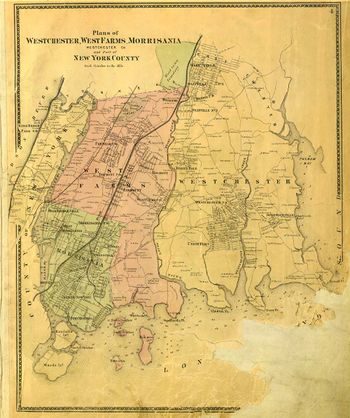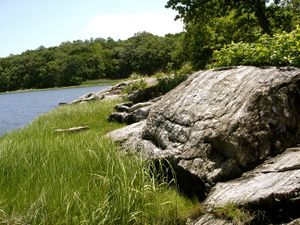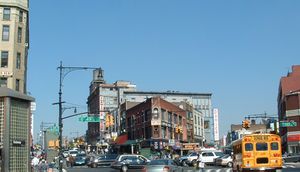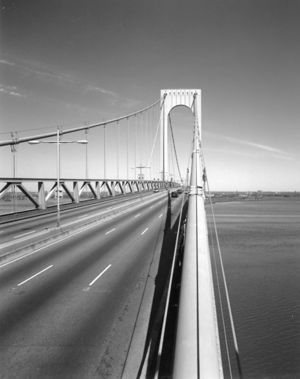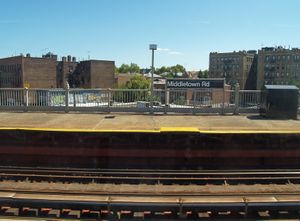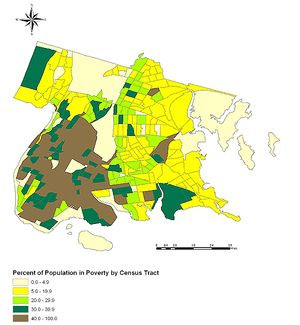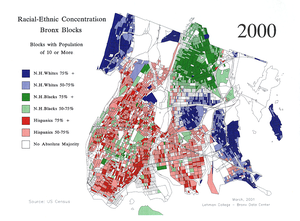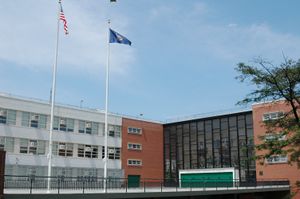برونكس
Bronx County
Rananchqua | |
|---|---|
حي في مدينة نيويورك | |
 منظر جوي للبرونكس واستاد يانكي | |
| الشعار: "Ne cede malis" Do not give way to evil | |
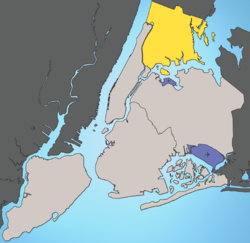 Location of The Bronx shown in yellow. | |
| الإحداثيات: 40°50′14″N 73°53′10″W / 40.83722°N 73.88611°W | |
| الدولة | الولايات المتحدة |
| الولاية | نيويورك |
| المقاطعة | برونكس |
| المدينة | مدينة نيويورك |
| Borough created | 1898 (County in 1914) |
| الحكومة | |
| • النوع | حي (مدينة نينيورك) |
| • Borough President | Ruben Diaz, Jr. — (Borough of the Bronx) |
| • District Attorney | Robert T. Johnson — (Bronx County) |
| المساحة | |
| • الإجمالي | 150 كم² (57 ميل²) |
| • البر | 110 كم² (42 ميل²) |
| • الماء | 40 كم² (15 ميل²) |
| أعلى منسوب | 90 m (280 ft) |
| التعداد (July 1, 2008 U.S. Census) | |
| • الإجمالي | 1٬391٬903 |
| • الكثافة | 12٬786/km2 (33٬116/sq mi) |
| منطقة التوقيت | UTC-5 (Eastern Standard Time (North America)) |
| • الصيف (التوقيت الصيفي) | UTC-4 (Eastern Daylight Time) |
| ZIP Code | 104 + two digits |
| مفتاح الهاتف | 718 , 347 |
| الموقع الإلكتروني | www.ilovethebronx.com—Official website of the Bronx Borough President |
برونكس، أحد الأحياء الخمسة لمدينة نيويورك وتقع في أقصي الشمال الشرقي. وهي أحدث المقاطعات ال62 لولاية نيويورك. وتقع في شمال شرق منهاتن وجنوب مقاطعة وستشستر، نيويورك، وبرونكس هي الحي الوحيد الذي لا يقع بصفة أساسية على جزيرة. في عام 2009، حسب تقديرات مكتب تقديرات الولايات المتحدة، وصل عدد سكان برونكس في 1 يوليو 2009 إلى 1,391,903,[1] يعيشون على مساحة 42 ميل مربع (109 كيلو متر مربع). مما يجعل برونكس الرابعة من أكبر خمس أحياء مكتظة بالسكان، الرابعة من حيث المساحة، وثالث الأحياء الأمريكية من حيث الكثافة السكانية.
The name "Bronx" originated with Swedish-born Jonas Bronck, who established the first settlement in the area as part of the New Netherland colony in 1639.[2][3][4] The native Lenape were displaced after 1643 by European settlers. In the 19th and 20th centuries, the Bronx received many immigrant and migrant groups as it was transformed into an urban community, first from various European countries (particularly Ireland, Germany, Italy and Eastern Europe) and later from the Caribbean region (particularly Puerto Rico, Haiti, Jamaica, and the Dominican Republic), as well as African American migrants from the southern United States.[5] This cultural mix has made the Bronx a wellspring of Latin music, hip hop and rock.
The Bronx contains the poorest congressional district in the United States, the 15th. There are, however, some upper-income, as well as middle-income neighborhoods such as Riverdale, Fieldston, Spuyten Duyvil, Schuylerville, Pelham Bay, Pelham Gardens, Morris Park, and Country Club.[6][7][8] Parts of the Bronx saw a decline in population, livable housing and quality of life in the late 1960s, 1970s and 1980s culminating in a wave of arson. The South Bronx, in particular, experienced severe urban decay. The borough experienced some redevelopment starting in the 1990s, preceding a more recent period of gentrification.[9]
نظرة سريعة على أقسام نيويورك الخمسة
| ||||
| الدائرة | التعداد | المساحة | ||
| قسم | مقاطعة | تقدير 1 يوليو 2008 |
ميل مربع |
كم2 |
| منهاتن | نيويورك | 1,634,795 | 23 | 59 |
| برونكس | برونكس | 1,391,903 | 42 | 109 |
| بروكلين | كينگس | 2,556,598 | 71 | 183 |
| كوينز | كوينز | 2,293,007 | 109 | 283 |
| ستاتن أيلاند | ريتشموند | 487,407 | 58 | 151 |
| 8,363,710 | 303 | 786 | ||
| 19,490,297 | 47,214 | 122,284 | ||
| المصدر: مكتب إحصاء الولايات المتحدة[1][10][11] | ||||
أصل الاسم
الأسماء المبكرة
The Bronx was called Rananchqua[12] by the native Siwanoy[13] band of Lenape (also known historically as the Delawares), while other Native Americans knew the Bronx as Keskeskeck.[14] It was divided by the Aquahung River.
The origin of the person of Jonas Bronck (ح. 1600–43) has been contested. Documents indicate that he was a Swedish-born emigrant from Komstad, Norra Ljunga parish, in Småland, Sweden, who arrived in New Netherland during the spring of 1639.[4][15][16][17][18][19] Bronck became the first recorded European settler in the present-day Bronx and built a farm named "Emmaus" close to what today is the corner of Willis Avenue and 132nd Street in Mott Haven.[20] He leased land from the Dutch West India Company on the neck of the mainland immediately north of the Dutch settlement of New Haarlem (on Manhattan Island), and bought additional tracts from the local tribes. He eventually accumulated 500 acre (200 ha) between the Harlem River and the Aquahung, which became known as Bronck's River or the Bronx [River]. Dutch and English settlers referred to the area as Bronck's Land.[15] The American poet William Bronk was a descendant of Pieter Bronck, either Jonas Bronck's son or his younger brother, but most probably a nephew or cousin, as there was an age difference of 16 years.[21] Much work on the Swedish claim has been undertaken by Brian G. Andersson, former Commissioner of NYC's Dept. of Records, who assisted in organizing a 375th Anniversary celebration in Bronck's hometown in 2014.[22]
التاريخ
European colonization of the Bronx began in 1639. The Bronx was originally part of Westchester County, but it was ceded to New York County in two major parts (West Bronx, 1874 and East Bronx, 1895) before it became Bronx County. Originally, the area was part of the Lenape's Lenapehoking territory inhabited by Siwanoy of the Wappinger Confederacy. Over time, European colonists converted the borough into farmlands.
إعادة الإحياء
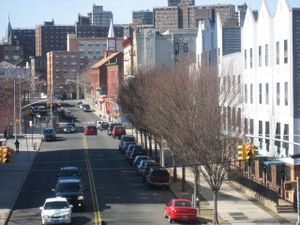
الجغرافيا
 مقالة مفصلة: جغرافيا مدينة نيويورك
مقالة مفصلة: جغرافيا مدينة نيويورك
المقاطعات المجاورة
- مقاطعة وستشستر - الشمال
- مقاطعة نيويورك (كوينز) - الجنوب
- مقاطعة نيويورك (منهاتن) - الجنوب الغربي
- مقاطعة برگن، نيوجرزي - الغرب

|
مقاطعة وستشستر | 
| ||
| إيستشستر باي | مقاطعة ر، نيوجيرسي | |||
| مقاطعة كوينز (كوينز) |
مقاطعة نيويورك (منهاتن) |
الموقع والخصائص الفيزائية
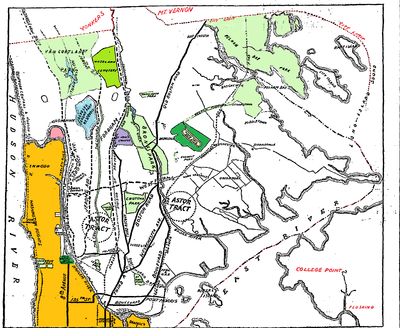
الحدائق والأماكن المفتوحة
الأحياء والمناطق التجارية
شرق برونكس
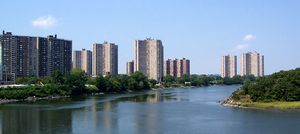
سيتي آيلاند و هارت آيلاند
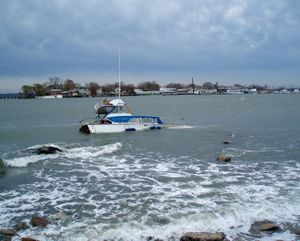
غرب برونكس
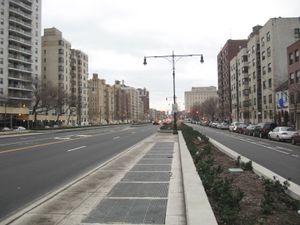
شمال غرب البرونكس
جنوب برونكس (أو جنوب غرب برونكس)
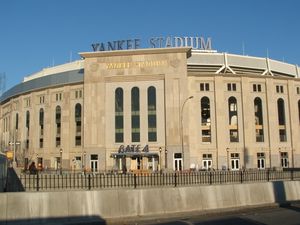
مناطق التسوق
محور برونكس
النقل
الطرق والشوارع
الطرق السريعة
الكباري والقنوات
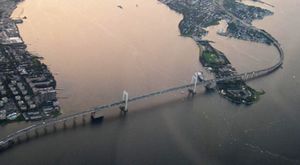
النقل الجماعي

ديموغرافيا
السكان والأسر
الدخل
العرقيات، اللغة، والهجرة
الحكومة والسياسة
الحكومة المحلية
التمثيل النيابي
التصويتات ومكاتب أخرى
الخدمة البريدية
التعليم
High schools
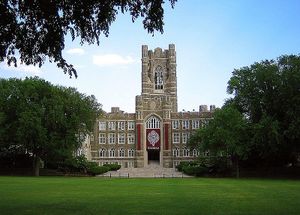
المؤسسات التعليمية
المؤسسات والحياة الثقافية
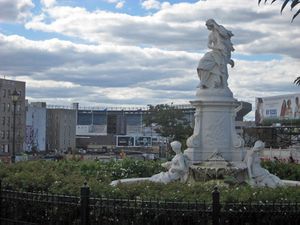
The press and broadcasting
برونكس كما تبدو على الشاشة، الأدب والأغاني
على الشاشة (الأفلام والتلفزيون)
في الأغاني
انظر أيضا
المصادر
- ^ أ ب Bronx County, New Yorkواسترجع في 15 مايو 2009 خطأ استشهاد: وسم
<ref>غير صالح؛ الاسم "2008 est pop" معرف أكثر من مرة بمحتويات مختلفة. - ^ Wylie, Jonathon (1987). The Faroe Islands: Interpretations of History. University of Kentucky Press. p. 209. ISBN 978-0-8131-1578-8.
Jónas Bronck (or Brunck) was the son of Morten Jespersen Bronck ... Jónas seems to have gone to school in Roskilde in 1619, but found his way to Holland where he joined an expedition to Amsterdam.
- ^ * "Jonas Bronx". Bronx Notables. Bronx Historical Society. Archived from the original on May 9, 2008. Retrieved January 20, 2012.
- van Laer, A. J. F. (October 1916). "Scandinavian Immigrants in New York, 1630–1674". The American Historical Review. Chicago: The University of Chicago Press on behalf of the American Historical Association. 22 (1): 164–166. doi:10.1086/ahr/22.1.164. JSTOR 1836219. ... Jonas Bronck was a Dane ...
- Burrows, Edwin G.; Wallace, Mike (Michael L.) (1999). Gotham, A History of New York City to 1898. Vol. 1. Oxford, New York: Oxford University Press. pp. 30–37. ISBN 0-19-511634-8.
... many of these colonists, perhaps as many as half of them, represented the same broad mixture of nationalities as New Amsterdam itself. Among them were Swedes, Germans, French, Belgians, Africans, and Danes (such as a certain Jonas Bronck)...
- ^ أ ب Van Rensselaer, Mariana Griswold (1909). History of the city of New York in the seventeenth century. Vol. 1. New York: The Macmillan Company. p. 161. OCLC 649654938.
- ^ Braver (1998)
- ^ "datatables". www.frac.org. Retrieved October 23, 2018.
- ^ خطأ استشهاد: وسم
<ref>غير صحيح؛ لا نص تم توفيره للمراجع المسماةBarone - ^ خطأ استشهاد: وسم
<ref>غير صحيح؛ لا نص تم توفيره للمراجع المسماةStat Abst - ^ See the "Historical Populations" table in History above and its sources.
- ^ County and City Data Book:2007 (U.S. Census Bureau), Table B-1, Area and Population, retrieved on July 12, 2008. New York County (Manhattan) was the nation's densest-populated county, followed by Kings County (Brooklyn), Bronx County, Queens County and San Francisco, California.
- ^ American Fact Finder (U.S. Census Bureau): New York by County - Table GCT-PH1. Population, Housing Units, Area, and Density: 2000 Data Set: Census 2000 Summary File 1 (SF 1) 100-Percent Data, retrieved on February 6, 2009
- ^ "Bronx History: What's in a Name?". New York Public Library. Retrieved March 15, 2008.
The Native Americans called the land Rananchqua, but the Dutch and English began to refer to it as Broncksland.
- ^ "Harding Park". New York City Department of Parks and Recreation. Retrieved March 15, 2008.
- ^ Ellis, Edward Robb (1966). The Epic of New York City. Old Town Books. p. 55. ISBN 0-7867-1436-0.
- ^ أ ب Hansen, Harry (1950). North of Manhattan. Hastings House. OCLC 542679., excerpted at The Bronx ... Its History & Perspective
- ^ van Laer, A. J. F. (1916). "Scandinavian Immigrants in New York, 1630–1674". The American Historical Review. Chicago: The University of Chicago Press on behalf of the American Historical Association. 22 (1): 164–166. doi:10.2307/1836219. JSTOR 1836219.
... Jonas Bronck was a Swede ...
- ^ Burrows, Edwin G.; Wallace, Mike (Michael L.) (1999). Gotham, A History of New York City to 1898. Vol. 1. Oxford, New York: Oxford University Press. pp. 30–37. ISBN 0-19-511634-8.
…many of these colonists, perhaps as many as half of them, represented the same broad mixture of nationalities as New Amsterdam itself. Among them were Swedes, Germans, French, Belgians, Africans, and Danes (such as a certain Jonas Bronck)...
- ^ "The first Bronxite". The Advocate. Bronx County Bar Association. 24: 59. 1977.
It is widely accepted that Bronck came from Sweden, but claims have also been made by the Frisian Islands on the North Sea coast and by a small town in Germany.
- ^ Karl Ritter, "Swedish town celebrates link to the Bronx" Associated Press, August 21, 2014. which also refers to a claim by the Faeroe Islands.
- ^ "The Bronx Mall – Cultural Mosaic – The Bronx... Its History & Perspective". Bronxmall.com. Retrieved July 12, 2016.
- ^ "Excerpts from an Interview with William Bronk by Mark Katzman". uiuc.edu.
- ^ Roberts, Sam (August 19, 2014). "A Bronck in the Bronx Gives a Swedish Town a Reason to Cheer" – via NYTimes.com.
- ^ FUTURE OF NEW WARDS; New-York's Possession in Westchester County Rapidly Developing. The New York Times, Wednesday, May 17, 1896, page 15 (The subheadlines continue "TROLLEY AND STEAM ROAD SYSTEMS Vast Areas Being Brought Close to the Heart of the City -- Miles of New Streets and Sewers. BOTANICAL AND ZOOLOGICAL GARDENS. Advantages That Will Soon Relieve Crowded Sections of the City of Thousands of Their Inhabitants.") This is a very useful glimpse into the state of the Bronx (and the hopes of Manhattan's pro-Consolidation forces) as parks, housing and transit were all being rapidly developed.
قراءات إضافية
- Barrows, Edward, and Mike Wallace. Gotham: A History of New York City to 1898 (1999)
- Baver, Sherrie L. "Development of New York's Puerto Rican Community," Bronx County Historical Society Journal 1988 25(1): 1-9
- Briggs, Xavier de Souza, Anita Miller and John Shapiro. 1996. "CCRP in the South Bronx." Planners' Casebook, Winter.
- Federal Writers' Project. New York City Guide: A Comprehensive Guide to the Five Boroughs of the Metropolis: Manhattan, Brooklyn, the Bronx, Queens, and Richmond (1939) online edition
- Gonzalez, Evelyn. The Bronx. (Columbia University Press, 2004. 263 pp. 0-231-12114-8), scholarly history focused on the slums of the South Bronx online edition
- Goodman, Sam. "The Golden Ghetto: The Grand Concourse in the Twentieth Century," Bronx County Historical Society Journal 2004 41(1): 4-18 and 2005 42(2): 80-99
- Jackson, Kenneth T., ed. The Encyclopedia of New York City, (Yale University Press and The New York Historical Society, (1995) ISBN 0-300-05536-6), has entries, maps, illustrations, statistics and bibliographic references on almost all of the significant topics in this article, from the entire borough to individual neighborhoods, people, events and artistic works.
- Jonnes, Jull. South Bronx Rising: The Rise, Fall, and Resurrection of an American City (2002) online edition
- Olmsted, Robert A. "A History of Transportation in the Bronx," Bronx County Historical Society Journal 1989 26(2): 68-91
- Olmsted, Robert A. "Transportation Made the Bronx," Bronx County Historical Society Journal 1998 35(2): 166-180
- Rodríguez, Clara E. Puerto Ricans: Born in the U.S.A (1991) online edition
- Samtur, Stephen M. and Martin A. Jackson. The Bronx: Lost, Found, and Remembered, 1935-1975 (1999) online review, nostalgia
- Ultan, Lloyd. The Northern Borough: A History Of The Bronx (2009), popular general history
- Ultan, Lloyd. The Bronx in the frontier era: from the beginning to 1696 (1994)
- Ultan, Lloyd. The beautiful Bronx (1920-1950) (1979), heavily illustrated
- Ultan, Lloyd. The birth of the Bronx, 1609-1900 (2000), popular
- Ultan, Lloyd. The Bronx in the innocent years, 1890-1925 (1985), popular
- Ultan, Lloyd. The Bronx: It Was Only Yesterday, "The Bronx: It Was Only Yesterday 1935-1965 (1992), heavily illustrated popular history
وصلات خارجية
وصلات عامة
- Bronx Borough President's Office
- The Bronx Times
- Weekly Bronx Report from Inner City Press
- Bronx County at the Open Directory Project
- Bronx travel guide from Wikitravel
- The Bronx River Alliance
- Bronx Council for Environmental Quality
أماكن في برونكس
- حديقة حيوان برونكس
- The New York Botanical Garden
- Bronx River Art Center
- Wave Hill: New York Public Garden and Cultural Center
- Walking tour of the Grand Concourse Boulevard-Cross Bronx Expressway area
- Walk in the Bronx
- Yankee Stadium
تاريخ برونكس
- متحف تاريخ برونكس
- The Bronx County Historical Society
- The Bronx: A Swedish Connection
- Report of the Bronx Parkway Commission, December 31, 1918, retrieved on July 24, 2008
- Remembrance of Synagogues Past: The Lost Civilization of the Jewish South Bronx by Seymour Perlin, retrieved on August 10, 2008
- Forgotten New York: Relics of a Rich History in the Everyday Life of New York City
- Bronx Nostalgia, photos, narratives, personal accounts, school alumni, videos
برونكس اليوم
- The South Bronx Overall Economic Development Corporation, retrieved on August 15, 2008
- Melancholy in the Bronx, but Not Because of the Stadium by David Gonzales, The New York Times, published and retrieved on September 19, 2008
- Pages using gadget WikiMiniAtlas
- Short description is different from Wikidata
- صفحات تستخدم جدول مستوطنة بقائمة محتملة لمفاتيح الهاتف
- Pages using infobox settlement with unknown parameters
- Articles containing Munsee-language text
- Articles with hatnote templates targeting a nonexistent page
- Pages with empty portal template
- Coordinates on Wikidata
- برونكس
- County seats in New York
- ضواحي مدينة نيويورك
- مدن تأسست في 1639
- United States communities with Hispanic majority populations
- West Indian communities in the United States

